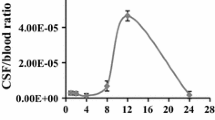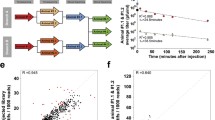Abstract
Phage display technology could provide a rapid means for the discovery of novel peptides. To find peptide ligands specific for the brain vascular receptors, we performed a modified phage display method. Phages were recovered from mice brain parenchyma after administrated with a random 7-mer peptide library intravenously. A longer circulation time was arranged according to the biodistributive brain/blood ratios of phage particles. Following sequential rounds of isolation, a number of phages were sequenced and a peptide sequence (CTSTSAPYC, denoted as PepC7) was identified. Clone 7-1, which encodes PepC7, exhibited translocation efficiency about 41-fold higher than the random library phage. Immunofluorescence analysis revealed that Clone 7-1 had a significant superiority on transport efficiency into the brain compared with native M13 phage. Clone 7-1 was inhibited from homing to the brain in a dose-dependent fashion when cyclic peptides of the same sequence were present in a competition assay. Interestingly, the linear peptide (ATSTSAPYA, Pep7) and a scrambled control peptide PepSC7 (CSPATSYTC) did not compete with the phage at the same tested concentration (0.2–200 pg). Labeled by Cy5.5, PepC7 exhibited significant brain-targeting capability in in vivo optical imaging analysis. The cyclic conformation of PepC7 formed by disulfide bond, and the correct structure itself play a critical role in maintaining the selectivity and affinity for the brain. In conclusion, PepC7 is a promising brain-target motif never been reported before and it could be applied to targeted drug delivery into the brain.






Similar content being viewed by others
References
Abbott NJ (2005) Physiology of the blood-brain barrier and its consequences for drug transport to the brain. Int Congr 1277:3–18
Abbott NJ, Patabendige AAK, Dolman DEM et al (2010) Structure and function of the blood-brain barrier. Neurobiol Dis 37:13–25
Arap W, Pasqualini R, Ruoslahti E (1988) Cancer treatment by targeted drug delivery to tumor vasculature in a mouse model. Science 279:377–380
Arap W, Haedicke W, Bernasconi M et al (2002) Targeting the prostate for destruction through a vascular address. Proc Natl Acad Sci 99:1527–1531
Barbas CF, Burton DR, Scott JK, Silverman GJ (2001) Phage Display: A laboratory manual. Cold Spring Harbor Laboratory Press, New York, pp 1.1–1.37
Barry MA, Dower WJ, Johnston SA (1996) Toward cell-targeting gene therapy vectors: selection of cell-binding peptides from random peptide-presenting phage libraries. Nat Med 2:299–305
Béduneau A, Saulnier P, Benoit JP (2007) Active targeting of brain tumors using nanocarriers. Biomaterials 28:4947–4967
Begley DJ (2004) Delivery of therapeutic agents to the central nervous system: the problems and the possibilities. Pharmacol Ther 104:29–45
Cabilly S (1999) The basic structure of filamentous phage and its use in the display of combinatorial peptide libraries. Mol Biotechnol 12:143–148
Cardarelli PM, Yamagata S, Taguchi I et al (1992) The collagen receptor-alpha-2-beta-1, from MG-63 and HT1080-cells, interacts with a cyclic RGD peptide. J Biol Chem 267:23159–23164
Costantino L, Tosi G, Ruozi B et al (2009) Colloidal systems for CNS drug delivery. Prog Brain Res 180:35–69
Demeule M, Regina A, Che C et al (2008) Identification and design of peptides as a new drug delivery system for the brain. Pharmacol Exp Ther 324:1064–1072
Gabathuler R (2010) Approaches to transport therapeutic drugs across the blood-brain barrier to treat brain diseases. Neurobiol Dis 37:48–57
Hu KL, Li JW, Shen YH et al (2009) Lactoferrin-conjugated PEG–PLA nanoparticles with improved brain delivery: In vitro and in vivo evaluations. J Control Rel 134:55–61
Huwyler J, Wu D, Pardridge WM (1996) Brain drug delivery of small molecules using immunoliposomes. Proc Natl Acad Sci 93:14164–14169
Joyce JA, Laakkonen P, Bernasconi M et al (2003) Stage-specific vascular markers revealed by phage display in a mouse model of pancreatic islet tumorigenesis. Cancer Cell 4:393–401
Kehoe JW, Kay BK (2005) Filamentous phage display in the new millennium. Chem Rev 105:4056–4072
Koivunen E, Wang BC, Ruoslahti E (1994) Isolation of a highly specific ligand for the α 5 β 1 integrin from a phage display library. J Cell Biol 124:373–380
Kolonin MG, Sun J, Do KA et al (2006) Synchronous selection of homing peptides for multiple tissues by in vivo phage display. FASEB J 20:E99–E107
Lee JH, Engler JA, Collawn JF, Moore BA (2001) Receptor mediated uptake of peptides that bind the human transferrin receptor. Eur J Biochem 268:2004–2012
Lee TY, Wu HC, Tseng YL, Lin CT (2004) A novel peptide specifically binding to nasopharyngeal carcinoma for targeted drug delivery. Cancer Res 64:8002–8008
Liu X, Chen C (2005) Strategies to optimize brain penetration in drug discovery. Curr Opin Drug Disc 8:505–512
Murai KK, Nguyen LN, Koolpe M et al (2003) Targeting the EphA4 receptor in the nervous system with biologically active peptides. Mol Cell Neurosci 24:1000–1011
Nicklin SA, White SJ, Watkins SJ et al (2000) Selective targeting of gene transfer to vascular endothelial cells by use of peptides isolated by phage display. Circulation 102:231–237
Pande J, Szewczyk MM, Grover AK (2010) Phage display: concept, innovations and future. Biotechnol Adv 28:849–858
Pardridge WM (2005) Molecular biology of the blood-brain barrier. Mol Biotechnol 30:57–70
Pasqualini R, Ruoslahti E (1996) Organ targeting in vivo using phage display peptide libraries. Nature 380:364–366
Pasqualini R, Koivunen E, Ruoslahti E (1997) Integrins as receptors for tumor targeting by circulating ligands. Nat Biotechnol 15:542–546
Pasqualini R, Koivunen E, Kain R et al (2000) Aminopeptidease N is a receptor for tumor-homing peptides and a target for inhibiting angiogenesis. Cancer Res 60:722–727
Praveen B, Alex B, Maiken N (2004) The blood-brain barrier: an overview: structure, regulation and clinical implications. Neurobiol Dis 16:1–13
Rajotte D, Arap W, Hagedorn M et al (1998) Molecular heterogeneity of the endothelium revealed by in vivo phage display. J Clin Invest 102:430–437
Re F, Cambianica I, Zona C et al (2011) Functionalization of liposomes with ApoE-derived peptides at different density affects cellular uptake and drug transport across a blood-brain barrier model. Nanomed Nanotech biol Med (in Press)
Régina A, Demeule M, Ché C et al (2008) Antitumour activity of ANG1005, a conjugate between paclitaxel and the new brain delivery vector Angiopep-2. Brit J Pharmacol 155:185–197
Roney C, Kulkarni P, Arora V et al (2005) Targeted nanoparticles for drug delivery through the blood-brain barrier for Alzheimer’s disease. J Control Rel 108:193–214
Rooy IV, Tascioglu SC, Couraud PO et al (2010) Identification of peptide ligands for targeting to the blood-brain barrier. Pharm Res 27:673–682
Ruoslahti E, Pierschbacher MD (1987) New perspectives in cell-adhesion-RGD and integrins. Science 238:491–497
Sidhu SS (2001) Engineering M13 for phage display. Biomol Eng 18:57–63
Smith GP (1985) Filamentous fusion phage: novel expression vectors that display cloned antigens on the virion surface. Science 228:1315–1317
Smith GP, Petrenko VA (1997) Phage Display. Chem Rev 97:391–410
Ulbrich K, Hekmatara T, Herbert E, Kreutre J (2009) Transferrin- and transferrin-receptor-antibody-modified nanoparticles enable drug delivery across the blood–brain barrier (BBB). Eur J Parm Biopharm 71:251–256
Wan XM, Chen YP, Xu WR et al (2009) Identification of nose-to-brain homing peptide through phage display. Peptides 30:343–350
Zhang Y, Pardridge WM (2005) Delivery of β-galactosidase to mouse brain via the blood–brain barrier transferrin receptor. J Pharmaco Exp Ther 313:1075–1108
Zou J, Dickerson MT, Owen NK et al (2004) Biodistribution of filamentous phage peptide libraries in mice. Mol Biol Rep 31:121–129
Acknowledgments
This work was supported in part by grants from the National Basic Research Program of China (973 Program) (2007CB935800), National Science and Technology Major Project 2009ZX09310-006 and Doctorial Innovation Fund of Fudan University. We thank Prof. L.P. Wen and Dr. X.M. Wang (University of Science and Technology of China, School of Life Sciences) for technological support in phage display screening.
Author information
Authors and Affiliations
Corresponding author
Rights and permissions
About this article
Cite this article
Li, J., Zhang, Q., Pang, Z. et al. Identification of peptide sequences that target to the brain using in vivo phage display. Amino Acids 42, 2373–2381 (2012). https://doi.org/10.1007/s00726-011-0979-y
Received:
Accepted:
Published:
Issue Date:
DOI: https://doi.org/10.1007/s00726-011-0979-y




